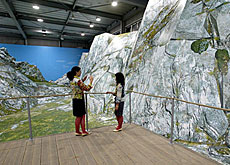Swiss hail “success” of World Expo

As the 2005 World Expo in Aichi, Japan, closes its doors, organisers of the Swiss pavilion say visitor numbers have beaten all expectations.
More than 20 million people attended the global exhibition during its six-month run, while the Swiss section of the expo received more than one million visitors.
Switzerland invested SFr15 million ($11.7 million) of government money in its presence at the first global exhibition of the 21st century.
The Swiss pavilion, built in the shape of an alpine mountain, was seen as an attempt to challenge the traditional image of Switzerland in Japan.
Heidi, cuckoo clocks and alpine cows were banished from the exhibition space, to be replaced with a selection of exhibits showcasing Swiss science, technology and innovation.
Manuel Salchli, director of the Swiss pavilion, told swissinfo the attempt to go beyond the clichés had paid off.
“The expo was a success for us. We exceeded all the targets we set ourselves,” said Salchli.
“The only problem is that over the past three to four weeks there have been far too many people on the site. Towards the end we had two-hour queues to get into the Swiss pavilion.”
There were also long waiting lines for the attached restaurant inside the pavilion, which served up a selection of specialities from the French-, German- and Italian-speaking regions of the country.
Focus on Japan
The vast majority – 95 per cent – of visitors to the expo were Japanese. According to Salchli, this gave organisers the opportunity to target a specific audience and invite them to change their perceptions of Switzerland as a tourist destination.
Some of the most popular items on display included Albert Einstein’s Swiss passport and inventions from the Federal Institute of Technology in Zurich designed to help the paralysed walk again.
Toshie Kumazawa, a 43-year-old housewife from Aichi, told swissinfo she had always thought of Switzerland as a “country of mountains”.
“But I discovered a new side to the country when I visited the pavilion,” she said.
“What interested me more than anything else was the equipment from the Federal Institute of Technology, particularly because my sister is herself paralysed.”
More tourists?
Aside from challenging traditional perceptions, one of the main aims of Switzerland’s presence in Aichi was to encourage more inbound tourism from Japan.
“We conducted a survey together with Switzerland Tourism to find out whether people were more inclined to visit the country after touring the pavilion,” said Salchli.
“Roughly 60 per cent of those questioned had never visited Switzerland before. And 86 per cent said the pavilion had left them more inclined to visit the country in the next few years.”
In an effort to build on the momentum created by the expo, Switzerland is planning to stage a variety of cultural exhibitions at museums and galleries around Japan over the next 12 months.
Next stop Shanghai
But attention is also turning to the next global exhibition which will open five years from now.
Salchli has already met organisers of Expo 2010, due to take place in the Chinese city of Shanghai.
“We have also had contacts with potential sponsors… and I think that interest from the private sector is going to be enormous.
“It’s estimated that 70 million people will visit the expo in Shanghai, so it’s going to be a very different challenge to the one in Japan.”
Salchli is giving little away about how Switzerland may present itself to the world in 2010. But he hints that next time around one of the most famous Swiss exports may make a return to the global stage.
“The Japanese here in Aichi were disappointed by the fact that they did not find Heidi in the Swiss pavilion. But it’s safe to say that she has not gone forever.”
swissinfo, Ramsey Zarifeh
Switzerland was one of more than 120 countries with pavilions at the 2005 World Expo.
The Swiss pavilion was able to operate at a maximum capacity of 7,000 people a day.
More than one million of the 20 million visitors to the expo found the time to tour the Swiss pavilion.
The first World Expo took place in London in 1851.
The most recent global exhibitions have taken place as follows:
1970: Osaka, Japan
1992: Seville, Spain
1998: Lisbon, Portugal
2000: Hanover, Germany
2005: Aichi, Japan
The next World Expo is due to take place in the Chinese city of Shanghai in 2010.

In compliance with the JTI standards
More: SWI swissinfo.ch certified by the Journalism Trust Initiative











You can find an overview of ongoing debates with our journalists here . Please join us!
If you want to start a conversation about a topic raised in this article or want to report factual errors, email us at english@swissinfo.ch.